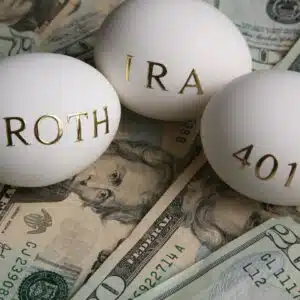Saving for retirement is one goal commonly shared by most individuals.
Unless you are independently wealthy or inherit enough money to feel confident you will never have to rely on savings (I did not have either one of these), you most likely want to put money aside during your working years to ensure your comfort and security when you retire.
Investing to build up a safety net for your future can start with as little as investing $1,000 or invest $500,000! You have to start somewhere!
This can be done in any number of ways, as there are dozens of different “types” of retirement savings plans from which to choose.
Each plan has its own benefits and drawbacks, making it important to find the one that best meets your current and long-term financial needs.
Members of the military and federal employees have additional savings tools at their disposal (such as a Thrift Savings Plan (TSP), making the decision where to save even more complicated.
Here, we look at two popular savings plans available to service members, their families, and United States Federal Government employees: the TSP vs. the Roth IRA.
Table of Contents
Roth IRA-After Tax Today For Tax-Free Later
A Roth IRA is available to any individual or married couple that falls under the income thresholds established by the IRS.
To be eligible as a contributor to a Roth IRA, you must make contributions from taxable compensation such as that received from self-employment, wages, salaries, commissions, and bonuses.
Members of the military, government, and civilians have access to a Roth IRA if they meet the required conditions.
Qualified distributions include the withdrawal of contributions at any time and earnings after the account is open for five tax years and the owner is 59 1/2 years of age.
These Roth IRA rules are very beneficial to individuals who may find themselves in a higher tax bracket when distributions are taken as income tax has already been paid, and no further taxation will occur.
Roth IRAs can be opened with almost any major brokerage. You can even get them in robo-advisors like Betterment and M1 Finance, who will do all the investing for you.
Thrift Savings Plans

Available to service members and federal employees, the Federal Thrift Savings Plan is another option to consider for retirement savings. This plan, commonly recognized by its acronym TSP, is similar to the standard 401k with which most savers are familiar.
Different from the Roth IRA in many ways, contributions to the TSP are made with pre-tax dollars, which reduces the amount of taxable income in the year contributions are made.
Of course, since taxes have not been paid on contributions, distributions from the TSP will be taxed. If you are in a higher income tax bracket when money is withdrawn, this can be a disadvantage.
Differences Between the Two – Roth IRA vs TSP
The differences between the two plans do not end with how they are taxed. Consider the following to help aid in your decision as to which plan is best for your financial needs.
- Contribution Limits: You can contribute up to $23,000 per year in the TSP for 2025 (or $30,500 if you’re 50 or older). 2025 Roth IRA contributions are permitted up to $7,000 per year (or $8,000 if you’re 50 or older).
- Minimum withdrawal age: TSP account owners must be 59 1/2 years of age to avoid early withdrawal penalties for distributions. Roth IRA owners may withdraw contributions at any age without penalty and earnings after age 59 1/2.
- Required Minimum Distributions (RMD): Minimum mandatory distributions must be taken from TSP at age 73 compared to the Roth IRA, which has no such requirement.
Failure to take the minimum required distribution results in a 50% penalty from the IRS.
Differences Between the Two – Roth IRA vs TSP
| ASPECT | ROTH IRA | TSP |
|---|---|---|
| Contribution Limits (2025) | $7,000 ($8,000 50+) | $23,000 ($30,500 50+) |
| Minimum Withdrawal Age | Any Age for Contributions, 59 1/2 for Earnings | 59 1/2 Years for All Distributions |
| Required Minimum Distributions | None | Starting at Age 73, Subject to Penalties for Non-compliance |
Which One Did I Do – The TSP or the Roth IRA?
Throughout my nine years of military career, I had access to both the Roth IRA and TSP. Since I was only in the National Guard, I mainly started with the Roth IRA because I had more control over my investments.
The TSP didn’t really become a viable option for me until I was deployed in 2005.
Even though I could have socked away a ton of cash into it, I still opted to max out mine and my wife’s Roth IRA. Between that and really upping our emergency funds, we decided to pass on the TSP.
Personally, I liked the control of the Roth IRA- I could invest in what I wanted– and the potential to have a tax-free nest egg waiting for me at retirement.
For active duty, the TSP might be more attractive since you can have it directly pulled out of your paycheck.
There are also many civil service jobs where they receive matching funds into the TSP. If that is the case, it is hard to recommend against free money. I would put in up to the match and then invest anything else in a Roth IRA account.
The Bottom Line – Choosing a Roth IRA or a TSP
The point of it all is that it’s never a bad thing to save. TSP or Roth- you just need to make sure you’re saving something for retirement. Both offer distinct advantages and, in some cases, disadvantages.
Soldiers who have access to both a Roth IRA and TSP may benefit by first maxing out contributions to a Roth IRA and then putting additional savings in the TSP to gain the most benefits from both plans.
FAQs on Roth IRA vs Thrift Saving Plans (TSP)
The main differences between a Roth IRA and a TSP include:
Eligibility: A Roth IRA is available to anyone, whereas a TSP is only available to federal employees and members of the uniformed services.
Contributions: Contributions to a Roth IRA are made with after-tax dollars, while contributions to a TSP are made with pre-tax dollars.
Withdrawals: Withdrawals from a Roth IRA in retirement are tax-free, while withdrawals from a TSP are taxed as ordinary income.
Limits: The contribution limit for a Roth IRA is $7,000 for 2025 and it’s subject to change. The contribution limit for a TSP is $23,000 for 2025.
es, you can have both a Roth IRA and a TSP. If you’re a federal employee or member of the uniformed services, you can contribute to both a TSP and a Roth IRA. However, you’ll need to consider your income and the contribution limits for each account to determine how much you can contribute.
A Roth IRA may be a better choice if you expect to be in a higher tax bracket in retirement or if you’re looking for more investment options.
A TSP may be a better choice if you’re a federal employee and looking for a simple, low-cost investment option.








DO NOT invest with TSP if you need any customer service. I was totally unable to do a simple change of beneficiary because of bad information and poor customer service. So I have withdrawn my entire balance (>$0.5M). TSP’s costs are low, but you get what you pay for.
Jeff,
Love your writing but you did not mention that members have the option (since 2012) to designate TSP contributions as Roth not just traditional. Since the TSP is still the cheapest option in town, most military members should first try to maximize their Roth TSP contributions before contributing to a Roth IRA.
@Daniel I was in the military (mostly part-time with one deployment) for 9 years and I never put a single penny into the TSP. Why? Yes, it’s very low cost, but cost shouldn’t be the only criteria in choosing your investments. The TSP, in comparison to a Roth, is very generic (ex. “G Fund”) and offers very few choices where with a Roth the choices are almost unlimited.
Jeff, I’ve just started listening to your podcasts recently so I knew that about your military service. I definitely have appreciate your advice and perspective in the ones I have listened to as well as on your blog. I’m active duty myself now (O-3 with 8 years service), but disagree with you that the TSP doesn’t offer enough options. For the average young investor starting out, using the C, S, and I funds can be everything they need. A Roth IRA is a great option as well, but should be the second option once the max TSP contribution is reached. For those later on in life, with more assets, or approaching retirement then yes, I think they need some more options that the TSP does not provide.
Good catch Daniel!
Jeff,
We can never talk too much about saving money! That new Roth TSP option is getting super popular. From November 2012 through December, the number of enrolled military members almost quadrupled. I imagine that number will continue to increase.
-Christian L. @ Smart Military Money
Hey, love this piece. I think it’d be worth mentioning that as of July 2012 the government has set up a Roth TSP option for employees. Also, although you can’t make withdrawals from TSP accounts, you are allowed to take out loans up to $50,000 at a low cost of $50. You pay these loans back with interest but the interest goes into your account. For these reasons, including yours regarding the contribution limits, I’m leaning on the Roth TSP. I recently made full time at my job so I changed my contributions from contributing 20% to the basic TSP to investing 5% to the basic TSP account and 20%to the Roth TSP account.I’m also expecting a promotion in the next few months that will boost me from $30,000 to $40,000, at which point I will increase my total contributions 5-10%. I havent decided how I’d allocate the increased contributions (roth or basic) yet though. I’m 26 years old and extremely new to this investing thing which also has a lot to do with my choice.
I am Planning to open a Roth IRA but I am nost sure where to open one.Is it safe to do it online or just open it at my local bank? I have friends that tell me to open at Vanguard,what do u recommend?
Whatever you do, DO NOT invest any money through a bank; go to any of the mutual fund companies, Vanguard, Fidelity, T Rowe Price, etc. and do it yourself online or by calling them toll free.
Vanguard usually has the lowest maintenance fees.